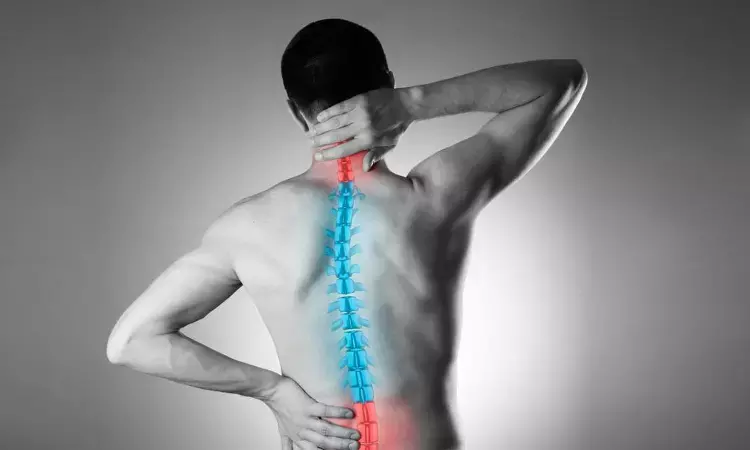- Home
- Medical news & Guidelines
- Anesthesiology
- Cardiology and CTVS
- Critical Care
- Dentistry
- Dermatology
- Diabetes and Endocrinology
- ENT
- Gastroenterology
- Medicine
- Nephrology
- Neurology
- Obstretics-Gynaecology
- Oncology
- Ophthalmology
- Orthopaedics
- Pediatrics-Neonatology
- Psychiatry
- Pulmonology
- Radiology
- Surgery
- Urology
- Laboratory Medicine
- Diet
- Nursing
- Paramedical
- Physiotherapy
- Health news
- Fact Check
- Bone Health Fact Check
- Brain Health Fact Check
- Cancer Related Fact Check
- Child Care Fact Check
- Dental and oral health fact check
- Diabetes and metabolic health fact check
- Diet and Nutrition Fact Check
- Eye and ENT Care Fact Check
- Fitness fact check
- Gut health fact check
- Heart health fact check
- Kidney health fact check
- Medical education fact check
- Men's health fact check
- Respiratory fact check
- Skin and hair care fact check
- Vaccine and Immunization fact check
- Women's health fact check
- AYUSH
- State News
- Andaman and Nicobar Islands
- Andhra Pradesh
- Arunachal Pradesh
- Assam
- Bihar
- Chandigarh
- Chattisgarh
- Dadra and Nagar Haveli
- Daman and Diu
- Delhi
- Goa
- Gujarat
- Haryana
- Himachal Pradesh
- Jammu & Kashmir
- Jharkhand
- Karnataka
- Kerala
- Ladakh
- Lakshadweep
- Madhya Pradesh
- Maharashtra
- Manipur
- Meghalaya
- Mizoram
- Nagaland
- Odisha
- Puducherry
- Punjab
- Rajasthan
- Sikkim
- Tamil Nadu
- Telangana
- Tripura
- Uttar Pradesh
- Uttrakhand
- West Bengal
- Medical Education
- Industry
Epidural interventions in management of chronic spinal pain: ASIPP Guideline

USA: The American Society of Interventional Pain Physicians (ASIPP) have released an updated version of epidural interventions in the management of chronic spinal pain.
Chronic spinal pain is the most prevalent chronic disease with employment of multiple modes of interventional techniques including epidural interventions. Multiple randomized controlled trials (RCTs), observational studies, systematic reviews, and guidelines have been published. The recent review of the utilization patterns and expenditures show that there has been a decline in utilization of epidural injections with decrease in inflation adjusted costs from 2009 to 2018.
ASIPP published guidelines for interventional techniques in 2013, and guidelines for facet joint interventions in 2020. Consequently, these guidelines , published in the journal Pain Physician, have been prepared to update previously existing guidelines.
In preparation of the guidelines, extensive literature review was performed. In addition to review of multiple manuscripts in reference to utilization, expenditures, anatomical and pathophysiological considerations, pharmacological and harmful effects of drugs and procedures, for evidence synthesis, the researchers included 47 systematic reviews and 43 RCTs covering all epidural interventions to meet the objectives.
Key recommendations include:
- Based on relevant, high-quality fluoroscopically guided epidural injections, with or without steroids, and results of previous systematic reviews, the evidence is Level I for caudal epidural injections, lumbar interlaminar epidural injections, lumbar transforaminal epidural injections, and cervical interlaminar epidural injections with strong recommendation for long-term effectiveness.
- The evidence for percutaneous adhesiolysis in managing disc herniation based on one high-quality, placebo-controlled RCT is Level II with moderate to strong recommendation for long-term improvement in patients nonresponsive to conservative management and fluoroscopically guided epidural injections.
- For thoracic disc herniation, based on one relevant, high-quality RCT of thoracic epidural with fluoroscopic guidance, with or without steroids, the evidence is Level II with moderate to strong recommendation for long-term effectiveness.
- Spinal stenosis: The evidence based on one high-quality RCT in each category the evidence is Level III to II for fluoroscopically guided caudal epidural injections with moderate to strong recommendation and Level II for fluoroscopically guided lumbar and cervical interlaminar epidural injections with moderate to strong recommendation for long-term effectiveness.
- The evidence for lumbar transforaminal epidural injections is Level IV to III with moderate recommendation with fluoroscopically guided lumbar transforaminal epidural injections for long-term improvement.
- The evidence for percutaneous adhesiolysis in lumbar stenosis based on relevant, moderate to high quality RCTs, observational studies, and systematic reviews is Level II with moderate to strong recommendation for long-term improvement after failure of conservative management and fluoroscopically guided epidural injections.
- Axial discogenic pain: The evidence for axial discogenic pain without facet joint pain or sacroiliac joint pain in the lumbar and cervical spine with fluoroscopically guided caudal, lumbar and cervical interlaminar epidural injections, based on one relevant high quality RCT in each category is Level II with moderate to strong recommendation for long-term improvement, with or without steroids.
- Post-surgery syndrome: The evidence for lumbar and cervical post-surgery syndrome based on one relevant, high-quality RCT with fluoroscopic guidance for caudal and cervical interlaminar epidural injections, with or without steroids, is Level II with moderate to strong recommendation for long-term improvement.
- For percutaneous adhesiolysis, based on multiple moderate to high-quality RCTs and systematic reviews, the evidence is Level I with strong recommendation for long-term improvement after failure of conservative management and fluoroscopically guided epidural injections.
"These epidural intervention guidelines including percutaneous adhesiolysis were prepared with a comprehensive review of the literature with methodologic quality assessment and determination of level of evidence with strength of recommendations," wrote the authors.
The guideline titled, "Epidural Interventions in the Management of Chronic Spinal Pain: American Society of Interventional Pain Physicians (ASIPP) Comprehensive Evidence-Based Guidelines," is published in the journal Pain Physician.
DOI: https://www.painphysicianjournal.com/current/abstracts?article=NzIwNQ==
Dr Kamal Kant Kohli-MBBS, DTCD- a chest specialist with more than 30 years of practice and a flair for writing clinical articles, Dr Kamal Kant Kohli joined Medical Dialogues as a Chief Editor of Medical News. Besides writing articles, as an editor, he proofreads and verifies all the medical content published on Medical Dialogues including those coming from journals, studies,medical conferences,guidelines etc. Email: drkohli@medicaldialogues.in. Contact no. 011-43720751


